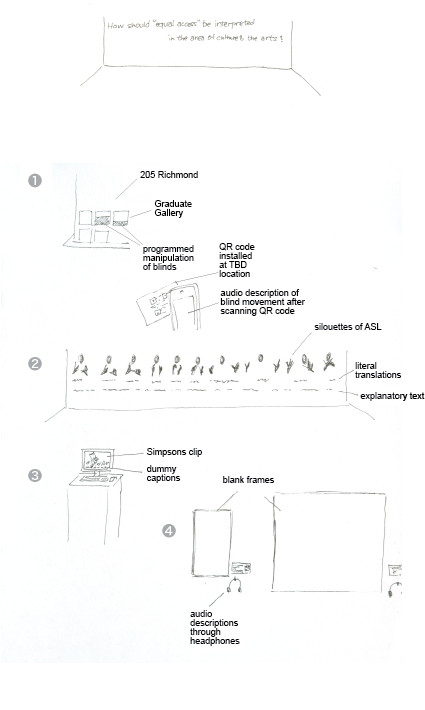Our proposal
Translation Objects: Traits and conditions of art and access
Location
The graduate gallery at 205 Richmond Street.
Description of Proposed Work
Using the container of a gallery where art is normally expected and perspective seemingly required, we want to install playful translation stations featuring devices, systems and concept languages commonly used to make works of art accessible to extreme users through translation. We are proposing 4 stations.
- Blind Reading: This is part of an on-going project where we are finding a way to encode Braille within the automated movements of window blinds. In this case the two windows and blinds in the gallery would run on a program of coded language and send messages for the duration of the show. A QR code will link to a website to audio descriptions of the blind readings.
- Speak the Wall: Tactile, silhouetted and dimensional gestures of ASL along one wall of the gallery describing the experience of unsound. Literal translation available through text. Many people don’t realize that ASL is a concept language in and of itself and not English.
- Simpson’s English: A cheap cardboard booth where English is taught by watching and repeating lines from the Simpsons. Captioned in non-sensical Mandarin and based on Qi Chen’s actually experience of learning English.
- You are Hear: Large Ornate picture frames that when touched activate audio descriptions of classic works of art. Audio description is the number one access tool used by Museums and Art Galleries to give access to visually impaired people. The audio descriptions used will be gathered before the show from various people attempting to describe the art.
In addition to these translation stations, a tactile guide track will be installed on the floor and walls and a question will float off one white wall translated into the other mediums of understanding the exhibit holds. (Mandarin, Braille, Audio Description, ASL, and Simpson). People will be invited to respond. Several other historical translation objects will be displayed
The second iteration of this exhibit would be to have a multi-sensory art call and show next year.

Artists Statement
As Master Students in Inclusive Design, we want to use art, performance and technology to reframe disability as a condition rather than a trait. With this and our other projects we will attempt to create the following:
The possibility of experiencing the mismatch between a user and their need and ability to participate in an experience.
The opportunity to think differently about the space in between knowing and not knowing. An interruption in what is perceived as normality in a world dominated by the common senses of sight and hearing and the english language. The chance to explore our expectations of language in spaces and to perhaps interrupt those expectations with curiosity followed by the frustration of not understanding and perhaps landing in the relief or discomfort of finding or not finding meaning. To ponder the idea of access not just as it pertaining to built environments but as a philosophy of inclusion.
Process work
Although we have not begun to formally gather our process work for this project some of this can be seen for our on-going project, Blind Reading: http://mdeslabteam5.tumblr.com/tagged/process
Time Line
- Gallery Booking: January 28–February 11
- Installation: Monday, January 28 to Wednesday, January 30
- Opening: Thursday, January 31
- Show: Thursday, January 28–Saturday, February 9
- Tear down: Sunday, February 10 and Monday, February 11
32 Pigeons
We are an art, performance and technology-making collective made up of design, theatre, and visual art professionals who landed together in the MDes in Inclusive Design this year at OCADU.
Contact
- Qi Chen
- Jan Derbyshire
- Ambrose Li
- Angela Punshon